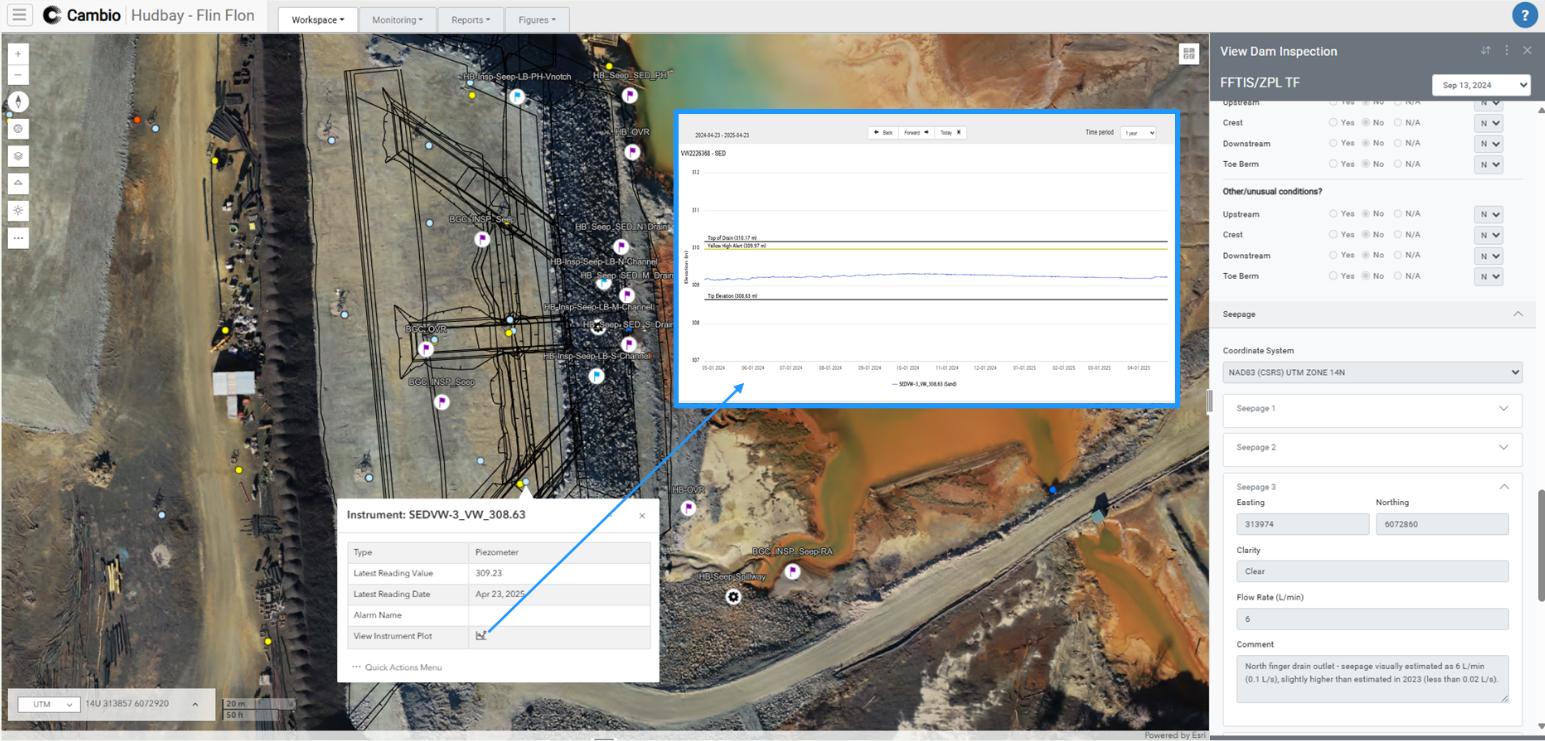Advancing Earth Science and Digital Innovation: Joint BGC and Cambio Earth R&D Symposium

We’re excited to partner once again with BGC Engineering for the upcoming R&D Symposium on October 30. It’s this kind of collaboration that keeps us grounded in applied geoscience and engineering expertise and it’s the foundation that continues to drive meaningful innovation across our shared work.
Earlier this year, Cambio Earth received a CIO Award for AI Innovation in Geohazard Monitoring, recognizing the impact of our research and development efforts to accelerate hazard detection and strengthen infrastructure resilience. The upcoming Symposium builds on that momentum, showcasing how collaboration between BGC and Cambio Earth is helping to translate advanced science into practical digital tools that make a real-world difference.
Our vision is simple: by working together with infrastructure operators, scientists, and engineers, we can leverage technology and applied earth science to prepare the world’s infrastructure for extreme weather and adapt to the challenges of a changing planet. That science-first foundation ensures everything we build remains accurate, meaningful, and trusted. This year’s Symposium continues that tradition, highlighting groundbreaking research and practical innovation across BGC’s global team and Cambio Earth.
From Understanding to Innovation: Keynotes that Frame the Future
The Symposium opens with Professor Dame Sarah Springman, whose keynote “Suction, Saturation, and Stability” explores the interplay between rainfall, bedrock, and vegetation in shaping landslide behavior. Her talk grounds the day in the physical realities of the natural world—the forces we seek to understand, model, and ultimately manage.
The afternoon keynote by Professor Kenichi Soga extends that foundation into the digital realm, highlighting how sensing technologies, data integration, and computational modeling are revolutionizing the way we observe and maintain infrastructure.
Together, these bookend perspectives—earth science and digital systems—frame the Symposium’s central theme: how applied research can evolve into actionable intelligence through technology.
AI-Powered Insights for Pipeline Safety: Cambio’s Machine Learning for Watercourse Geohazards
One of the morning’s featured talks comes from Aron Zahradka, Data Science Lead at Cambio Earth, presenting “Multi-Model, Probabilistic Machine Learning for Pipeline Watercourse Geohazard Assessment.”
Pipelines face complex hydrotechnical hazards where watercourses intersect buried infrastructure. Traditionally, understanding these hazards required extensive field inspections. An approach that, while thorough, can be resource-intensive and difficult to scale across large networks.
Cambio Earth, in partnership with BGC, is addressing this challenge head-on. Using a multi-model, probabilistic machine learning workflow, Aron’s team has developed an automated method to predict key hydrotechnical risk values—such as probability of failure, exposure, and scour depth—based on watershed, stream, and pipeline characteristics.
The results have been transformative:
- Automated risk screening helps identify and prioritize which crossings need physical inspection.
- Comparative analytics flag potential data inconsistencies, improving the quality and reliability of inspection results.
- Integration into Cambio™ allows engineers to view predictive results alongside inspection data, satellite and lidar imagery, and Cambio’s continental stream network.
In early analyses, the model closely matched predicted probabilities of failure against field data, suggesting substantial potential cost savings if automated analysis were used to complement or reduce inspection frequency. Beyond savings, the approach unlocks new potential for rapid, proactive risk management, helping operators focus on the sites that matter most.
.png)
Detecting Change at Scale: Deep Learning for Landslide Mapping
Later in the afternoon, Dr. Corey Scheip presents “A Deep Learning Approach to Rapidly Map Thousands of Active Landslides with Lidar Change Detection.”
This research draws from an initiative that recently won a CIO Award—representing a breakthrough in how geoscientists use AI to interpret lidar data. While lidar and other remote sensing technologies generate vast volumes of high-resolution data, manually interpreting them for ground movement or slope instability can take weeks or months. We’re changing that.
By training deep learning models, similar to the ones used to recognize everyday objects like cars or faces, to detect subtle terrain changes, we’ve created a workflow that automatically maps active landslides across massive lidar datasets in hours. The approach uses segmentation models to generate high-resolution polygons ready for review, validation, and GIS integration with confidence.
.jpeg)
The implications are far-reaching:
- Rapid hazard response following major storms or seismic events.
- Proactive risk management for transportation corridors, pipelines, and communities in landslide-prone terrain.
- Scalable monitoring that can have a global impact, from Canada’s mountain towns to river valleys in Southeast Asia.
“We spent a lot of time and effort to do this right, and the results speak for themselves – our model is consistently finding landslides that even experts have missed” said Dr. Scheip.
Advancing Rock Slope Management through Semi-Quantitative Risk Assessment Algorithms
To close the day, Zac Sala will present “A Semi-Quantitative Rock Fall Risk Assessment Tool for Highway Corridors” highlighting how a new multi-consequence risk assessment algorithm is transforming a DOTs ability to assess rock slope risk and prioritize risk management actions.
Rock slopes are a geotechnical asset which transportation operators must manage to provide safe and efficient highway operation. A variety of rock fall and rock slope rating systems have been developed over the years to help prioritize slopes for mitigation and maintenance. These systems have typically been score based with limited ability to compare across hazard types and focused primarily on impacts to public safety. Our updated system considers public safety, as well as loss of service due to highway closure, and direct maintenance and repair costs for owners. The method is probabilistic and risk-based, producing an estimate of annual risk exposure in dollars. The expression of risk in dollars allows users to compare site across hazard types more easily and supports cost-benefit analysis directly. The inclusion of other objectives such as loss of service is an important consideration for decision-makers when life loss risk may not justify mitigation on its own.
This semi-quantitative approach is data-driven and pairs perfectly with the Cambio Platforms tools for managing geohazard site inventories and linear infrastructure data. Now DOTs can take their highway data, import or build their rock slope inventory, complete rock slope assessments, and prioritize sites for action all in one place! Implementing the system in Cambio also means its field ready, so users can complete assessments in the field, syncing them to the office for review. Our new rock fall algorithm is just the first step, look out for debris flow, embankments, and earth landslide related algorithms in the future!
“Seeing this algorithm implemented in Cambio is an exciting milestone after years of incremental improvements. Moving from a spreadsheet to a platform like Cambio unlocks use of this new tool by many more rock slope practioners than was possible before and has already led to exciting collaboration between BGC, our clients, and other consultants,” said Sala.
Innovation Across Disciplines
While these talks exemplify the fusion of data science and applied earth engineering, the Symposium’s broader agenda showcases BGC’s multidisciplinary strength:
- Tailings research that strengthens dam breach modeling and risk assessment.
- Fiber optic sensing and lab testing innovations that deepen understanding of soil and rock behavior.
- AI-driven parameter estimation that bring new precision to traditional geotechnical workflows.
Science and Technology for a Changing Planet
The 2025 BGC & Cambio Earth R&D Symposium highlights a simple but powerful truth: technology is only as valuable as the science it’s built upon. Cambio Earth’s AI-driven initiatives aren’t about replacing engineering judgment—they’re about amplifying it.
Together, we are building a future where applied earth science and digital intelligence work hand in hand—to make infrastructure safer, more resilient, and better prepared for a changing world.
.svg)

.png)
